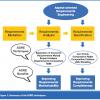 |
Why Do Requirements Matter? A series of dining mishaps leads Lee to reflect on why mistakes happen in spite of well-defined requirements.
|
|
|
|
Managing Your Analysis Debt What is your project's analysis debt load? What's the difference between good and bad analysis debt? What are causes and remedies for such debt? Mary Gorman and Ellen Gottesdiener explore the concept of analysis debt and consider strategies for prudent investing.
|
|
|
|
The Whos and Wheres of Stakeholder Requirements Whether you're working on a collocated or a distributed team, it's important to take stakeholder requirements into account: "Who" are they and "where" are they located? In this article, Mary Gorman offers some tips to help you narrow the gap between thinking and acting globally and locally.
|
|
|
|
How Agile Practices Reduce the Top 5 Requirements Risks Requirements risks are among the most insidious risks threatening software projects. Whether it is having unclear requirements, lack of customer involvement in requirements development, or defective requirements, these troubles are a major culprit in projects that go awry. As requirements expert and agile coach Ellen Gottesdiener explains, agile practice can go a long way in mitigating the top five requirements risks.
|
|
 |
Building a Foundation for Structured Requirements: Aspect-Oriented Requirements Engineering Explained (Part 2) Aspect-oriented requirements engineering (AORE) is a new methodology that can help us to further improve the analysis, structure, and cost of development of software requirements. The second part of this two-part series focuses on the AORE specification techniques.
|
|
 |
Building a Foundation for Structured Requirements: Aspect-Oriented Engineering Explained (Part 1) Aspect-oriented requirements engineering (AORE) is a new methodology that can help us improve the analysis, structure, and cost of development of software requirements. AORE does not replace but rather complements any of the existing requirements methodologies. This two-part paper explains to software practitioners the AORE concept, illustrates how it can be applied on software projects, and discusses the benefits of AORE. Part I focuses on the AORE analysis techniques.
|
|
|
|
Bringing Your Requirements Discussions Down to Earth Trying to communicate with businesspeople about requirements can make you feel like you're from another planet. Using concrete examples expressed as storytests to drive the development of a system can help bring you back into the same orbit. Discover ways to introduce this process on your next project.
|
|
|
|
The Peculiar Nature of Requirements Turn to The Last Word, where software professionals who care about quality give you their opinions on hot topics. This month, Karl Wiegers shares some common misperceptions about requirements.
|
|
 |
Alter Your Requirements Process Fashioning a new requirements method is an almost impossible task, given budget and time constraints. But that doesn't mean you have to be stuck with an ill-fitting process. Learn about seven alterations that almost any organization can make.
|
|
|
|
You Don't Say You've just developed and tested a system that meets each of the customer’s stated requirements. So why aren't they satisfied? Lisa Crispin shares her 5-step process for uncovering hidden assumptions and requirements so that everyone can have the happy ending they expected.
|
|
